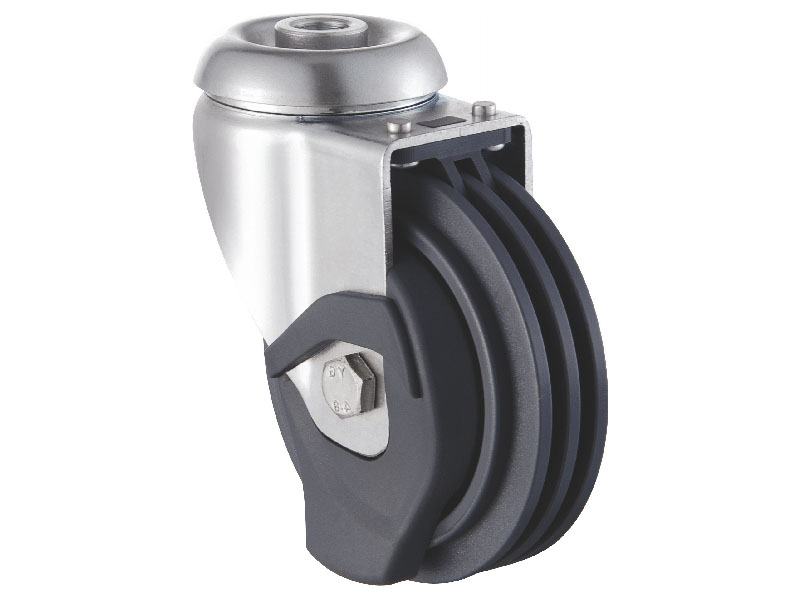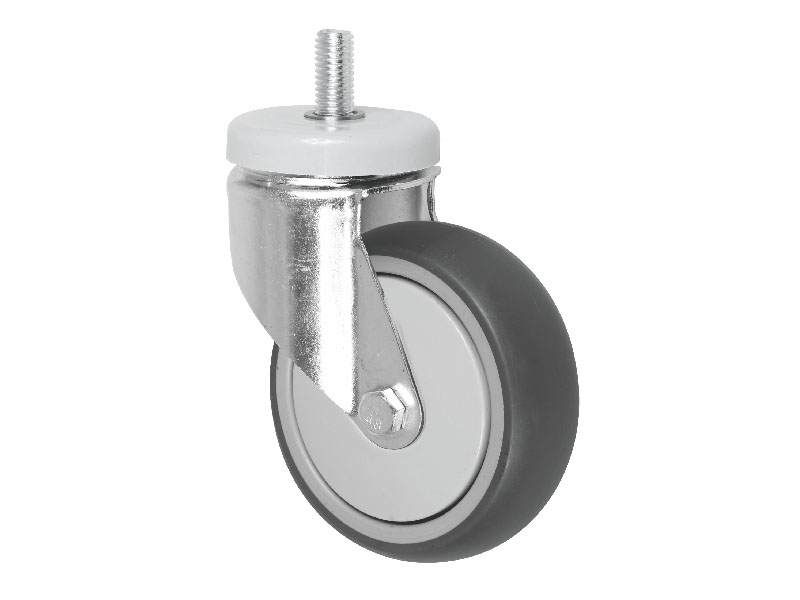The Persistent Plight of Poly Caster Wheels Wear: Causes, Consequences, and the Caster Wheels Solution

I. Unraveling the Causes of Poly Caster Wheels Wear
A. Material of Poly Caster Wheels – Related Weaknesses
Rubber Caster Wheels
Rubber caster wheels are popular for their elasticity, which absorbs shocks. In hospitals, this ensures a smooth ride for patients. But elasticity makes them prone to wear. On rough surfaces, the constant flexing of rubber causes degradation. Small particles from the ground can embed in the soft rubber, creating holes and weakening the wheel. Over time, the rubber loses its shape – retaining ability, leading to uneven wear. Rubber also ages and degrades due to sunlight, heat, oxygen, and chemicals like oils and solvents.
Plastic Caster Wheels
Plastic caster wheels are rigid, but they lack flexibility. Plastic is brittle and cracks under impact or stress. In cold – storage warehouses, low temperatures make plastic wheels extremely brittle. A minor impact can shatter them. The molecular structure of plastic is weak. Repeated stress from rolling, loading, and temperature changes can break its molecular bonds. This leads to a loss of strength and makes plastic wheels more likely to deform under heavy loads.
B. Load – Induced Wear
Overloading
Every caster wheel has a load – bearing limit. Exceeding this limit can have serious consequences. Overloading a hand – truck, for example, can flatten the wheel tread and bend the axle. In extreme cases, the bearings may seize, the axle may break, or the wheel may burst. Even repeated non – extreme overloading can gradually weaken the wheel’s components. In logistics warehouses, frequent overloading for tight schedules can lead to more frequent wheel replacements and supply – chain disruptions.
Uneven Load Distribution
Uneven load distribution can cause caster wheel wear. When the weight on a vehicle or equipment is uneven, some wheels bear more load. In a furniture – moving truck with unevenly stacked furniture, the wheels on one side wear out faster. This uneven wear can also lead to instability and accidents. Dynamic loads like sudden stops, starts, and sharp turns can accelerate wheel wear. In an airport baggage – handling area, the constant exposure to such loads makes baggage – cart wheels wear quickly.
C. Environmental Challenges
Rough Surfaces
Rough surfaces, such as those in construction sites or industrial floors with debris, are very abrasive to caster wheels. The small protrusions on these surfaces act like sandpaper, wearing away the wheel tread. Rubber wheels, being soft, are especially vulnerable to abrasion. Plastic wheels may crack or chip when rolling over large or sharp objects. Metal – rimmed wheels, though more resistant, can still have their bearings and other components damaged by vibrations and impacts from rough surfaces.
Chemical Exposure
In industrial settings like chemical plants and laboratories, caster wheels are exposed to corrosive chemicals. Acids, alkalis, and solvents can react with the wheel materials and cause degradation. A rubber – wheeled cart in a chemical plant may have its rubber dissolve when it contacts sulfuric acid. In a laboratory, plastic caster wheels can be damaged as solvents break down the plastic’s molecular bonds. Long – term chemical exposure, even if not severe, can gradually weaken the wheels and make them more likely to wear and fail.
Temperature Extremes
Cold temperatures can affect caster wheels, especially those made of rubber or plastic. In cold – storage warehouses, rubber becomes hard and brittle, losing its elasticity and shock – absorbing properties. It’s more likely to crack under stress. Plastic wheels also become more brittle and are at a higher risk of cracking when impacted or loaded. Hot temperatures can cause rubber to soften and deform. In a foundry or furnace – room environment, rubber – wheeled carts may experience rapid wear as the rubber becomes soft and sticky. Plastic wheels may warp or melt at high temperatures.
II. The Far – Reaching Consequences of Caster Wheel Wear
A. Safety Hazards
Instability and Falling Objects
Worn caster wheels can make equipment or vehicles unstable. As the wheels wear unevenly, the object may tilt or wobble. In a warehouse, a stack of pallets on a cart with worn wheels may topple over, endangering workers. In a hospital, a patient on a bed with malfunctioning wheels may be at risk of injury if the bed moves unpredictably.
Skidding and Loss of Control
Worn caster wheels can cause skidding, especially in wet or oily environments. In a food – processing plant, a cart with worn wheels may skid on wet or greasy floors, leading to accidents and product damage. Skidding can also occur when the wheels are too worn to provide enough friction for braking, increasing the risk of collisions.
B. Cost Implications
Frequent Replacements
Frequent caster wheel replacements due to wear can be costly. In large – scale industrial operations, the cost of new wheels, including shipping and handling, adds up. A manufacturing plant may need to replace conveyor – system wheels every few months, affecting the company’s bottom line.
Downtime and Lost Productivity
When caster wheels wear out and need replacement, equipment may be out of service. In a factory, a forklift with failed wheels may be idle for hours or days. This downtime leads to lost productivity, with the cost of idle workers, missed production targets, and potential delivery delays being much higher than the cost of the wheels.
C. Impact on Equipment Lifespan
Accelerated Wear of Other Components
Worn caster wheels can cause other equipment components to wear out faster. When wheels don’t roll smoothly, axles and bearings have to work harder. This can bend axles and wear bearings more quickly. In a shopping cart, worn wheels can stress the frame, leading to cracks and damage, reducing the equipment’s lifespan.
Reduced Efficiency and Performance
As caster wheels wear, equipment efficiency and performance decline. The increased friction and resistance make the equipment consume more energy. In an electric – powered forklift, worn wheels can drain the battery faster. The reduced performance can also lead to lower – quality output, as it’s harder to move materials precisely or maintain production speed.
III. Poly Caster Wheels: The Ideal Solution
A. Exceptional Wear – Resistance
The Science Behind Polyurethane’s Durability
Poly Caster Wheels are made of polyurethane. It has a unique molecular structure with cross – linked long chains of organic polymers. These cross – links can absorb friction and impact energy, protecting the wheel from damage. The tight – knit structure also keeps abrasive particles from penetrating, preventing wear.
Long – Term Performance in High – Wear Environments
In high – traffic and high – wear environments like factories and logistics warehouses, Poly Caster Wheels are durable. In a large – scale distribution center, they can maintain their integrity much longer than traditional rubber or plastic wheels. They can withstand continuous rolling, heavy – load impacts, and abrasive floors. This reduces replacement frequency and saves time and money.
B. High Load – Bearing Capacity
Engineering for Heavy – Duty Applications
Poly Caster Wheels are designed for heavy loads. Their tread thickness, hub strength, and bearing quality are optimized. The polyurethane material has high tensile strength, allowing it to support heavy weights without deforming. In a steel – manufacturing plant, these wheels can support large steel coils. The wide tread distributes the load evenly, reducing pressure per unit area.
Load – Bearing in Extreme Conditions
Even in extreme conditions like high – temperature environments or sudden impacts, Poly Caster Wheels can maintain their load – bearing capacity. In a foundry, heat – resistant wheels can support heavy molten metal containers. When a heavy – duty cart experiences a jolt or impact, the polyurethane’s shock – absorbing properties dissipate the energy, ensuring the wheel can still bear the load.
Chemical Resistance of Poly Caster Wheels
Resilience Against a Wide Range of Chemicals
Polyurethane resists a wide range of chemicals, including acids, alkalis, and solvents. In a chemical – processing plant, Poly Caster Wheels can operate without being affected. For example, when exposed to hydrochloric acid, they can keep their structure and function. This makes them suitable for industries with common chemical exposure.





